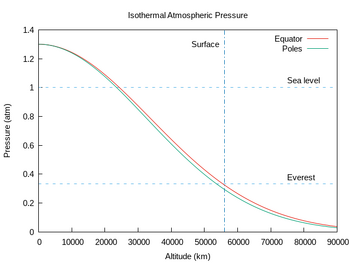This is part 2 of a 2-post series that started here, as a result of a very interesting discussion with Lhynard and Moviesign about the gravity and composition of Coliar.
Coliar is a gas giant. As a size G spherical air body, it is about the size of Jupiter. How then could it have an Earth-like gravity and even be inhabitable all the way to its core? Jupiter has an enormous mass and an equally enormous gravity. Moreover, it has a very narrow range of altitudes at which the pressure allows for the survival of humanoids. Below that, its crushing pressures mean certain death to all but the sturdiest of xorns.
The easy to tackle question regards Coliar's gravity. From the previous post, one surmises that a G-sized air body would have a surface gravity of only 0.2% of Earth's. However, Coliar is not entirely made only of air. It has numerous earthmotes floating around, distributed more or less homogeneously throughout the planet's interior. Considering the density of earth, we can then compute what the contribution of those motes would have to be for Coliar to have a surface gravity of 1 g.
Due to the planet's large size (remember that gravity decreases with the square of the distance to the center), the answer is an astounding 78 Earth masses of islands. This enormous amount of land mass, whose surface could easily cover the surface of Toril 400 times over,[note 1] would only be responsible for 1% of the volume of the planet. Most of Coliar would still consist of empty air, the average distance from one earthmote to the next being around 800 km.
What would the air pressure be like on such an environment? Again, one could say that magic guarantees a homogeneous pressure throughout the entire volume of the gas giant. Let us see if we can do better.
The main forces acting on a gaseous planetary body are gravity and air pressure. The latter is regulated by the density and temperature. We can now try to solve the hydrostatic equilibrium equations to see what we find. Let us assume for simplicity that Coliar's atmosphere is isothermic―there is no significant change in temperature with a change in altitude.[note 2] Even with this assumption and with the presence of earthmotes dampening our gravity everywhere inside the planet, we hit a wall: at room temperature, the air would rapidly collapse to a sphere no larger than 900 km in radius around the planet's center, and the entire population of aarakocra and lizardfolk suffocates.[note 3]

Isothermal atmospheric pressure as a function of radius on the equatorial and polar regions of Coliar. The dot-dashed line represents the average surface of a G-size planet. Earth-equivalent values placed as dashed lines for reference.
Unless the air of Coliar itself is under the same kind of spell that allows the earthmotes to float in the first place. A powerful feather fall spell could act as a dampening factor that reduces the air compression and also allows the earthmotes to effectively acquire orbital velocities at much slower speeds. We find that a planet-wide feather fall 20 times stronger than the usual spell keeps not only the air at comfortable pressures throughout the planet, but also allows for the earthmotes to stay in orbit, endlessly roaming around the aerial expanse.
What could fuel this powerful spell. We don't know. Maybe a powerful magical effect in the central earthmote, guarded zealously by the dragon Firebrand Flametongue. It could be a giant space hamster-powered contraption at the core of the planet for all we know. Diligent giant space hamsters keeping the wheels of Realmspace turning forever, placed there by Ao himself.
It's hamsters all the way down.
Notes[]
- ↑ Assuming that the average diameter of the earthmotes is 16 km and that only the upper half of their surface is inhabitable.
- ↑ This simplifying hypothesis has no physical justification. Most likely the temperature would rise to Jupiter-like levels as one approaches the core.
- ↑ The solution to the hydrostatic equilibrium equations for an isothermal fluid is given by a gaussian whose width depends on the temperature, the molar mass and the central pressure of the gas.

